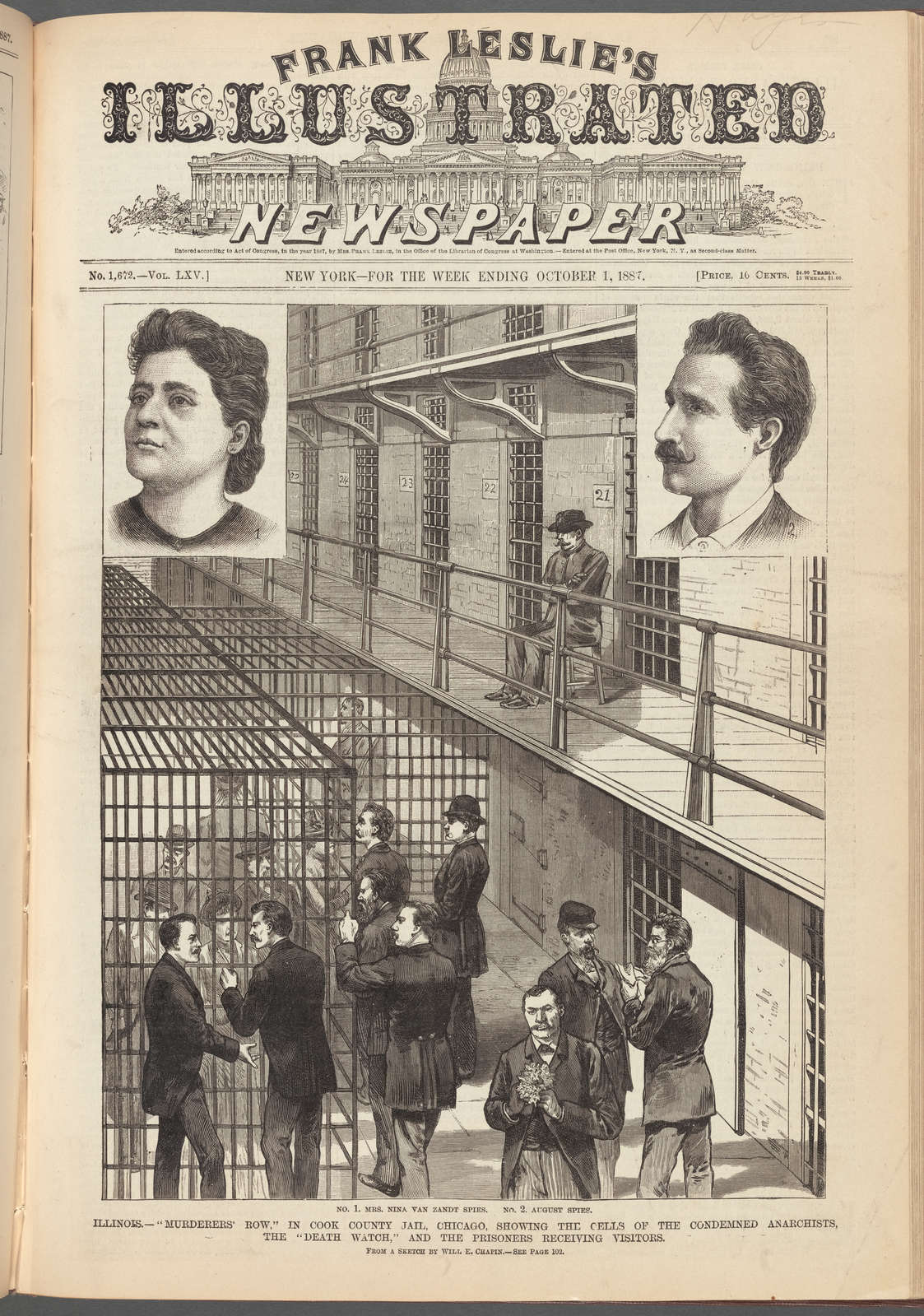Create a free profile to get unlimited access to exclusive videos, sweepstakes, and more!
Chicago's 'Mrs. Bluebeard,' Tillie Klimek

In the city of Chicago in the 1920s, the lady murderer was decidedly in.
You might be familiar with Chicago's infamous "murderesses' row" from the musical Chicago. The musical actually isn't that far off from the truth, likely because it's based on actual events. The show is inspired by a 1926 play by Maurine Dallas Watkins, a playwright who spent several months working for The Chicago Tribune. At the newspaper, she covered the trials of Beulah Annan and Belva Gaertner, two young women accused of murder in 1924. They went on to be acquitted of their crimes. Watkins privately thought both were guilty and became convinced that her sassy, stylish coverage of the two women gained so much public sympathy that their "celebrity" affected the jury.
And so a legend was, if not born, then observed. If a young, white, and conventionally attractive woman found herself standing trial before one of Cook County's all-male juries, she could (as Watkins' play was later called to differentiate it from the musical) Play Ball by appealing to the press and jury with her "feminine wiles."
It's not surprising that this system was baffled when Tillie Klimek, along with her cousin Nellie Koulik, was arrested for murder in 1922 just two years before Annan and Gaertner. She was about as far from the doe-eyed Beulah Annan as you could get: a no-nonsense, middle-aged Polish immigrant storekeeper with stern features and a dark sense of humor. But Klimek reached heights that a cabaret singer picking off a scumbag boyfriend couldn't reach: four husbands and boyfriends dead by arsenic. And that's just the start. Along with Nellie, the Chicago police attributed up to twenty poisoning cases to the two women. From the fall of '22 to the spring of '23, visions of a secret society of killer Polish housewives led by Tillie Klimek thrilled Chicagoans.
The newspapers never let Tillie forget that she was no ingenue. But who needs to be an ingenue when you can be Mrs. Bluebeard?
When Joseph Klimek met Tillie in the early 1920s, he was looking for a home. Once widowed, once divorced, Klimek was, by Chicago Tribune reporter Genevieve Forbes' account, a quiet, gentle man. After his divorce, his friends began to try and play matchmaker to help him along.
He actually already knew Tillie. He'd been friendly with Frank Kupczyk, her late husband, and even paid her a visit after Frank's death. But his friends thought they'd be an excellent match and made a more formal introduction. He was thrifty, had a steady job, and just wanted to settle down. Tillie was a good housekeeper and an astonishingly good cook. It might not have been a grand romance, but it didn't need to be to make a good home. The two were married in 1921.
To mark the occasion, Tillie destroyed every photo and letter she had of ex-husbands and ex-boyfriends. The infatuated Joseph saw this as a touching display of loyalty, rather than a huge red flag.
The next year, Joseph fell ill and did not improve. When he became so gravely ill that he ended up in the hospital, the doctors thought his symptoms looked suspicious and ran a few tests. When the results came back, they confirmed the doctors' suspicions: Joseph was dying of arsenic poisoning.
Suspicion, as it usually does, immediately fell on the spouse, and the Chicago police arrested Tillie. After hours of interrogation, Tillie confessed to poisoning her husband. Joseph had been an alcoholic who abused her and cheated on her, she claimed. It had absolutely nothing to do with the life insurance policies recently taken out on him!
While corroborating the story, the police found another suspect: Nellie Koulik, Tillie's neighbor and cousin. Nellie confessed to providing Tillie with the rat poison she used to poison Joseph. "She told me her husband was cruel to her and she wished she could poison him," she told the police.
The story might have ended there if Tillie had not already survived several husbands. Being a widow was certainly not uncommon, but Tillie had buried three husbands and at least one boyfriend. It was suspicious, to say the least. The Chicago police requested permission to exhume the body of Tillie's late husband Frank.
And once they started digging up corpses, they couldn't stop.
Frank was filled with, as the police put it, "enough [arsenic] to fill four men." As they began to exhume Joseph Mitkiewicz, Tillie's first husband, an anonymous tip came in saying that Nellie's first husband, Wojcik Sturmer, should be exhumed for examination too. It was like dominoes falling. Once Tillie had been arrested for poisoning, a tidal wave of friends, relations, and neighbors came out of the woodwork to accuse the cousins of poisoning them or their loved ones, successfully or unsuccessfully. Everywhere the police turned for answers, there seemed to be another mysterious death or mysterious illness after visiting Tillie's kitchen. The papers rapturously followed each twist and turn.
As the smoke began to clear, a better picture of Tillie emerged. Born Otylia Gburek in Poland in 1876, her family immigrated to Chicago shortly after her birth, settling in Little Poland on the north side of town. Not much is known about the young Tillie. She married her first husband, John Mitkiewicz, in 1890, at only 14 years old. Despite her young age, they seemed to have a perfectly unremarkable marriage, until Mitkiewicz died of "heart trouble" in January of 1914.
She took no time finding a new husband—and losing him. She married Joseph Ruskowski the next month, but he died the following April, only three months later. Not one to waste time, Tillie got herself back on the market and met Joseph Guszkowski.
Oddly, Tillie let it slip that she had poisoned Ruskowski early in the relationship. The two went on a steamy trip to Milwaukee, where the topic of marriage came up. Guszkowski refused to marry her. Tillie, angered, told him she'd report him for violating the Mann Act by taking her across state lines for sex. The Mann Act of 1910 was a federal law prohibiting the transportation of women across state lines "for the purpose of prostitution or debauchery, or for any other immoral purpose." (It remains on the books to this day, though the language has been amended so it's less likely to be used to criminalize consensual activity.) Guszkowski pointed out that she was a murderer and that he'd report her first.
He died shortly after.
There may have been another man between Guszkowski and Kupczyk, her next husband. While defending herself on the stand, Tillie claimed that she'd married Frank five weeks after the death of her previous husband. But the next marriage on record is her marriage to Frank Kypczyk on February 17th, 1919, who died on April 25th, 1921. And then, of course, Joseph Klimek entered the picture.
As the Chicago police dug up ex-husband after ex-husband, they discovered that each of them had been fatally poisoned with arsenic. Tillie Klimek had been at this a long time, as had Nellie.
And those were just the husbands and boyfriends. As the Chicago police investigated the flood of tips, they ultimately identified twenty victims. Thirteen of the poisonings had been successful. Most were family members in Tillie and Nellie's large extended family: nieces, nephews, sisters-in-law… even their own children and grandchildren. While married to Wojcik, Nellie had given birth to twins. Wojek refused to accept them as his, believing them to be the children of one of their boarders inside. The two infants died within the year.
Seven victims, however, had survived. One such survivor was Nellie's nephew by marriage, Nick Micke, who called police himself to accuse his wife and mother-in-law, Nellie's sister, of poisoning him. The women were arrested on suspicion. While they were later released, that did nothing to calm fears of a pack of Mrs. Bluebeards ravaging Little Poland with Tillie at the helm.
Despite the avalanche of accusations, Tillie and Nellie were only charged for the murder of their respective husbands. Both women pleaded not guilty. When a Chicago Tribune reporter visited Tillie in jail as she awaited trial, she grumbled, "everybody [makes] eyes at me like [they're] going to eat me. Why do they make eyes at me like that? I tell the truth. Anything I did I did to myself. Nobody else."
But the witnesses in Tillie's trial were compelling. Tillie is sometimes said to have made self-fulfilling "prophecies" about her murders, but she never made such claims in life. Rather, she had a terrible habit of cracking dark jokes that almost gave the "game" away. (Presumably, this is how Guszkowski figured her out.) Her landlady testified that Tillie merrily sat at Frank's deathbed, working away on her mourning veil, and tried to store a bargain coffin in the shared basement—before Frank had even died. The nurse attending to Joseph Klimek, recovering in the hospital, reported that Tillie had joked that, if her patient gave her any trouble, she should just beat him over the head with a two by four. Tillie couldn't even help herself in court. "Isn't it a shame," she quipped to Genevieve Forbes "to keep the poor judge and jury working overtime. They won't get no dinner. Isn't it a shame?"
Tillie's congeniality baffled Marcus Kavanagh, the judge who presided over her trial. How could someone who had become so popular with the other women in the jail and was known as an excellent housekeeper and cook be such a remorseless murderer? She was obviously guilty — the evidence was staggering — but she felt no guilt. "If this woman was let loose today," the judge told the Chicago Tribune, "she would kill another man."
The prosecution argued for the death penalty for two reasons: the severity of Tillie's crimes and to combat the idea that women could get away with murder willy nilly in Chicago. But, as Judge Kavanagh discusses in his book The Criminal and His Allies, the jury was unwilling to be so harsh to a woman, despite the evidence against her. If Tillie had been young and pretty, he concluded, that jury wouldn't have the heart to sentence her to life in prison. She was sent to Joliet Correctional Center to serve her sentence, where she would die in 1936.
Oddly enough, it was Nellie that managed to get away with murder, though she spent a little over a year in prison awaiting trial. The state nolle prossed (or abandoned) the charge of murder of her first husband, and she was found not guilty of providing Tillie with arsenic. She might not have been an ingenue, Nellie's big blue eyes and easy-to-read emotions made her a more sympathetic character than her grim, bemused cousin to the press and to juries. There's more than one way to play ball.


























